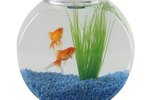
When setting up an aquarium, one of the most important aspects of high water quality is water movement. Stagnant water can lead to a number of problems in your tank, including poor filtration, algae growth and low oxygen levels. Making sure you have a proper filter will keep your fish happy and healthy.
Oxygen
Just like you, fish absorb oxygen and produce carbon dioxide. Proper water movement allows for the oxygen-rich water at the top of the tank to be circulated into the lower parts of the tank. This means that all the critters in your tank get the oxygen they need. If the water were to be stagnant, carbon dioxide would build up in the tank and suffocate your fish.
Oxygen distribution isn’t just important for your fish, but for bacteria, too. Good bacteria live in your tank that breakdown harmful toxins in the water. If water is stagnant and low in oxygen, many of these bacteria will die, causing the water to become toxic.
Filtration
Currents in your tank allows for organic debris -- fish waste and left over food -- to be brought to the open areas of the tank and picked up by your mechanical filter. If the water is stagnant, this matter will settle into nooks and crannies in the bottom of the aquarium and lead to an overgrowth of algae.
Heat
Most tropical fish require warm temperatures to survive. Proper water movement in your tank will distribute heat radiated from the heater throughout the aquarium. If the water stops moving, the tank will grow too cold in some spots and too warm in others, which can be fatal especially to fish that are sensitive to abrupt temperature changes.
Fish Health
Water currents also provide exercise for your fish. Swimming against the current helps keep your fish active in the relative confines of an aquarium. Water movement is particularly important in saltwater aquariums. Many corals and other invertebrates require a current moving past them to obtain oxygen and food since they don’t swim. In a stagnant aquarium, they would die from both nutrient and oxygen starvation.
Keep It Moving
A good rule of thumb when figuring out flow rate is to take the gallons of water in your aquarium and multiply it by four. This means that in a 50-gallon tank, 200 gallons of water is turned over every hour, expressed as 200 gph. Research the fish you are keeping to determine what kind of flow rate they will require. Creatures that live in the open ocean often require higher flow rates than young or slow-swimming species. Having a generator or battery backup will help keep the water moving in case of a power outage or natural disaster. Investing in a battery-operated air pump is an inexpensive way to take out some extra insurance against water becoming stagnant.
References
- LiveAquaria.com: Aquarium Water Movement and Fish Health
- Doctors Foster and Smith: Your Aquarium's Current of Life
- Ecotech Marine: Why Water Flow is Important to a Marine or Reef Aquarium
- LiveAquaria.com: Choosing the Proper Flow Rate for Your Aquarium
- FishChannel.com: Keeping Aquarium Fish Alive During a Power Outage or Other Disaster
Photo Credits
-
Comstock Images/Comstock/Getty Images




